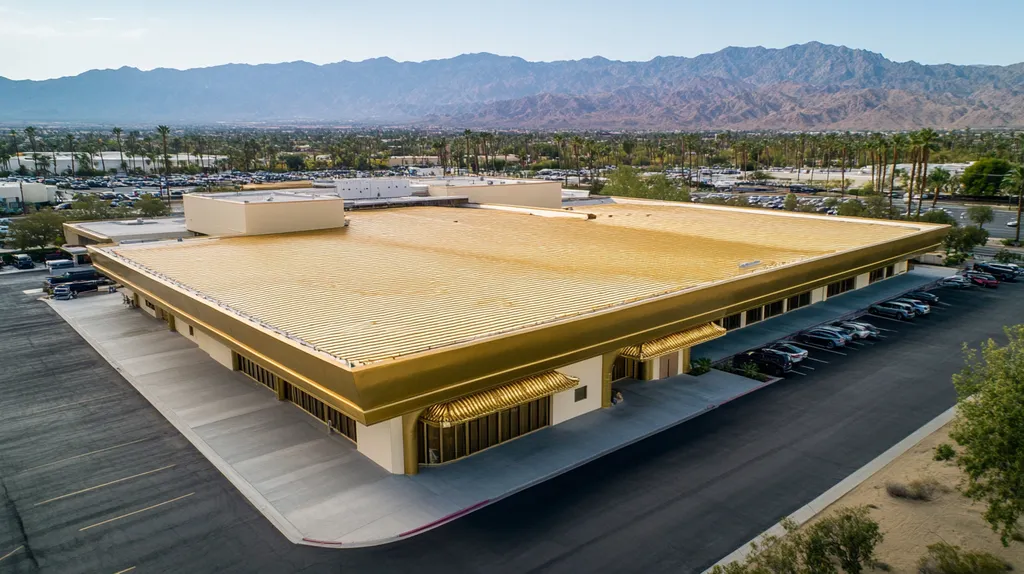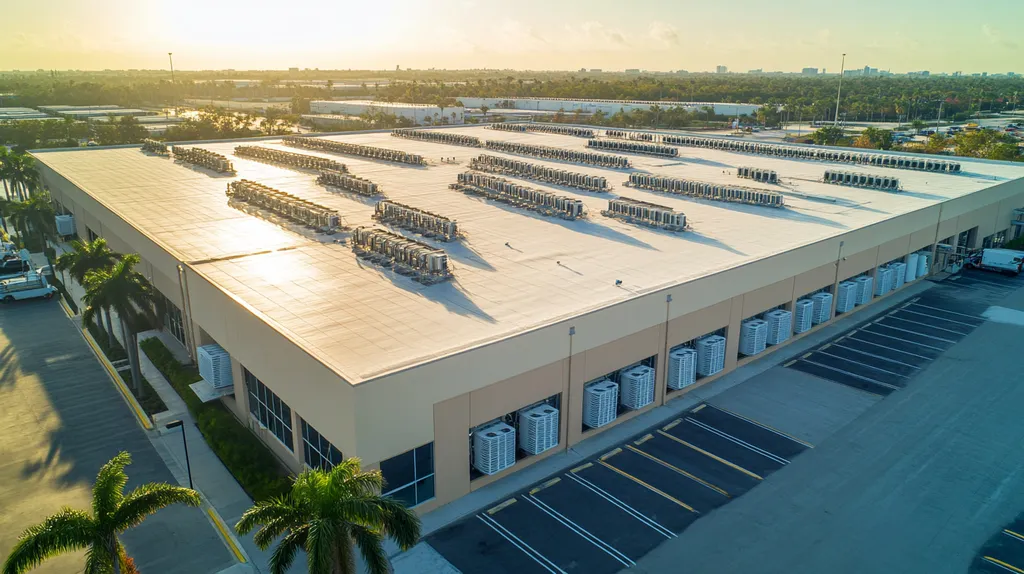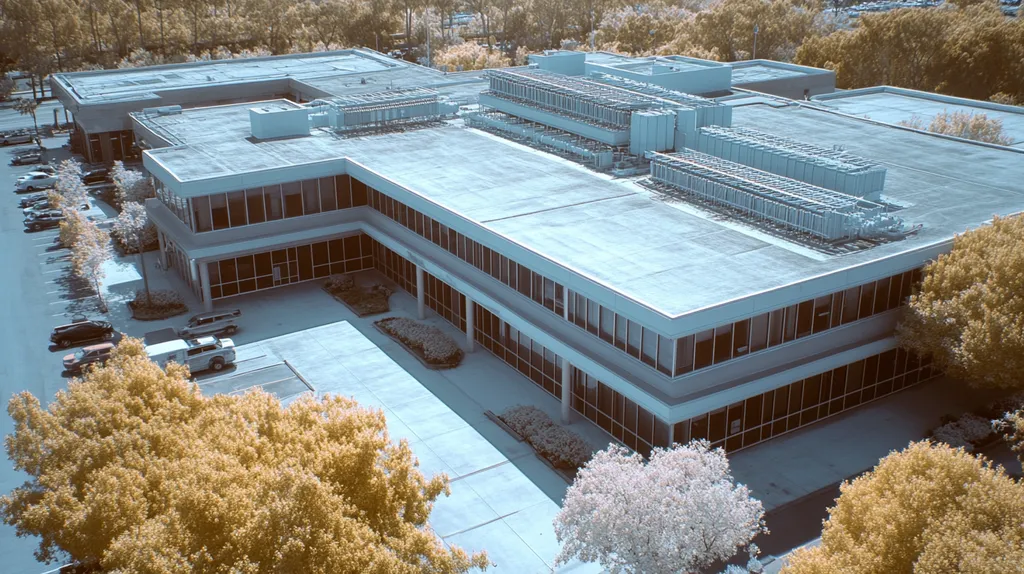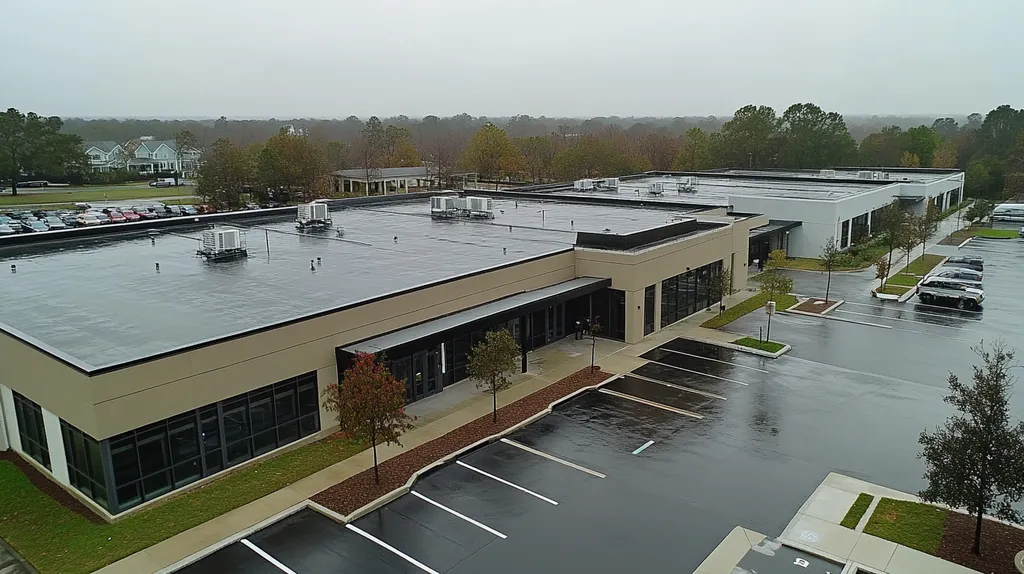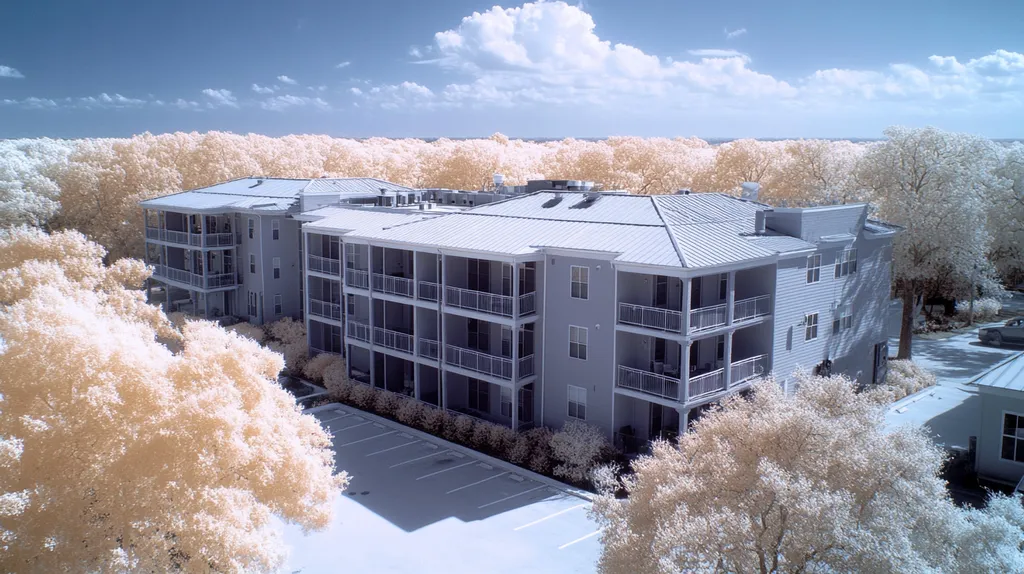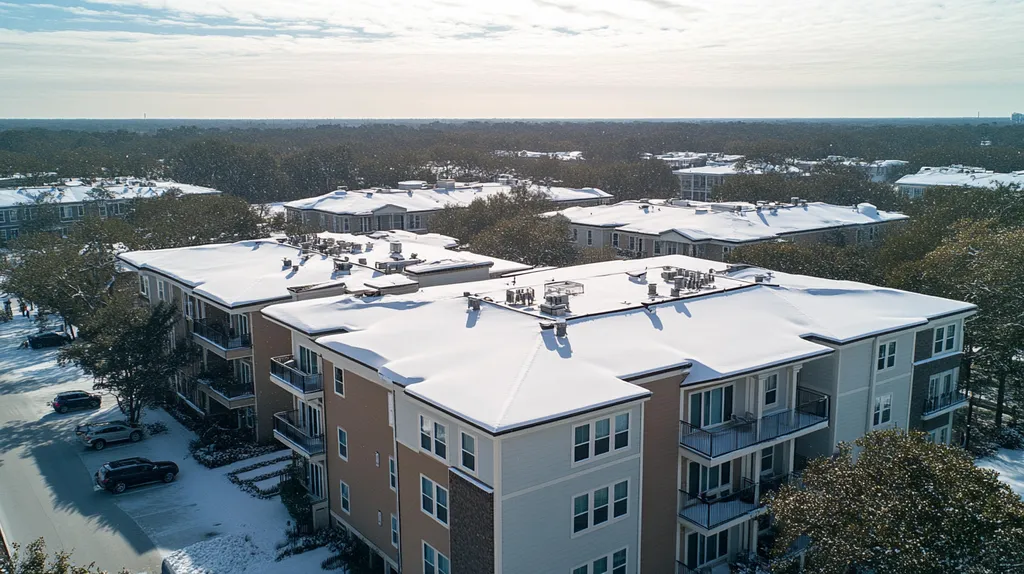Every year, more than 300 workers lose their lives due to falls from industrial roofs, with thousands more suffering serious injuries that could have been prevented through proper hazard assessment.
Current evaluation methods, while standardized across the industry, often fail to identify critical risks that endanger workers and expose property owners to significant liability.
This analysis examines systemic flaws in established roof hazard assessment protocols, revealing how inadequate training, fragmented evaluations, and insufficient enforcement create dangerous gaps in worker protection.
SECTION 1: CURRENT PRACTICES
Industrial roofing work carries significant risks that can jeopardize the safety of workers and lead to expensive accidents. In 2022 alone, OSHA reported over 300 fatalities in the construction industry due to falls, many linked to roof operations. This highlights the urgent need for thorough hazard assessments that help property owners and facility managers mitigate risks and enhance safety. While current methods have been established over time, they often don’t identify all potential dangers effectively. This section will delve into the practice of annual compliance checks, standard assessment protocols, and the safety equipment commonly utilized in the industry.
Annual Compliance Checks
Annual compliance checks are a common practice among industrial facilities, aimed at meeting regulatory standards and keeping meticulous safety records. However, this once-a-year approach can foster a false sense of security among property owners.
Many hazards can emerge throughout the year due to changing environmental conditions, wear and tear on equipment, or new construction activities. For example, a roof that initially seems secure can present new dangers after a significant weather event. Ignoring these evolving risks can expose companies to unsafe working environments.
To combat this issue, property owners should consider implementing more frequent assessments or even real-time monitoring technologies. This proactive strategy allows for the identification and management of hazards as they arise rather than depending solely on annual inspections.
By transitioning from annual to more continuous evaluations, facilities can respond to risks in a timely manner. This shift is crucial for ensuring a safer working environment for roofing professionals.
Standard Assessment Protocols
Standard assessment protocols typically rely on checklists that highlight obvious risks, such as roof slope and nearby hazards. While these protocols establish a basic framework, they often overlook site-specific conditions that may present unique dangers. For instance, a protocol may neglect to address increased slip risks caused by water pooling in rooftop low spots.
Moreover, standardized protocols frequently lack input from the workers who are on the roof regularly. These employees can provide valuable insights, revealing hazards such as misplaced equipment or accumulated debris. Involving field personnel can dramatically enhance the effectiveness of hazard assessments.
To improve safety and risk management, companies should consider customizing their assessment protocols based on specific site conditions. By incorporating employee feedback, they can achieve a more complete understanding of the hazards present.
Moving away from generic assessments allows property owners to create more robust evaluations that better address their specific needs. This tailored approach not only improves safety outcomes but also fosters a culture of vigilance and care on the job site.
Commonly Used Safety Equipment
Safety equipment is vital for protecting workers on industrial roofs. Tools such as harnesses, guardrails, and safety nets serve as essential defenses against falls. However, the true effectiveness of this equipment hinges on proper usage and regular maintenance.
In many instances, safety gear may be present but not utilized effectively. For example, a worker might wear a harness that isn’t securely fastened, rendering it useless during a fall. Regular training sessions and scheduled inspections are crucial to ensuring that safety equipment is utilized correctly.
Additionally, the need for continuous updates and improvements in safety equipment should not be overlooked. With advancements in technology, new safety gear can offer better protection and increased functionality. Investing in modern equipment can significantly enhance risk mitigation efforts.
To optimize safety, property managers should prioritize training focused on how to use safety equipment correctly and the importance of regular assessments. Promoting awareness around the proper use and upkeep of safety tools can help cultivate a culture of safety among workers.
SECTION 2: SYSTEMIC ISSUES
Assessing hazards on industrial roofs is crucial for ensuring worker safety, yet systemic issues persist that undermine these efforts. Challenges such as inadequate training programs, overreliance on warning lines, and neglect of skylight hazards contribute to heightened risks. These flaws not only endanger workers but can also result in costly delays and legal liabilities for property owners, creating a critical urgency for reform.
Inadequate Training Programs
Many training programs for roofing workers remain outdated and inadequate. While general safety protocols exist, they often fail to address the specific hazards found on industrial roofs. This lack of tailored instruction can leave workers ill-equipped to recognize and mitigate risks unique to their environments.
For instance, workers might receive training focused on general fall protection without guidance on navigating distinctive features of an industrial roof. This oversight can significantly heighten the risks during challenging weather conditions. Without the right education, preventable accidents may occur, leading to injuries that could have been easily avoided.
Moreover, ongoing education is frequently neglected. Safety protocols and technologies change over time, yet many training programs do not evolve accordingly. Property owners must prioritize regular refreshers that keep workers aware of new risks and best practices to navigate the ever-changing landscape of industrial roofing.
Ultimately, the inadequacy of training programs puts everyone involved at risk, increasing the likelihood of injuries, fatalities, and rising insurance costs. A commitment to improved training can dramatically enhance safety on industrial roofs.
Overreliance on Warning Lines
Warning lines are a commonly used measure for fall protection on roofs, but their effectiveness can sometimes be overstated. Many workers may develop a false sense of security solely because a warning line is present, leading them to engage in risky behaviors.
This overreliance can result in dangerous actions, such as leaning over or stepping past the warning line, often leading to falls. Research indicates that a considerable percentage of roofing injuries occur when workers mistakenly assume they are safe near these lines. Without additional safeguards, the risk of accidents remains alarmingly high.
Furthermore, warning lines do not account for environmental factors that can make a roof hazardous, such as wind, rain, or ice. Yet, many contractors neglect to revisit safety protocols in light of changing weather conditions, relying solely on these cautionary measures.
Property owners must acknowledge the limitations of warning lines and encourage a more comprehensive approach to fall protection. By incorporating additional safety measures, they can significantly enhance worker safety and minimize liability.
Neglect of Skylight Hazards
While skylights can enhance natural lighting and energy efficiency, they also pose serious safety risks that are frequently overlooked. Many property owners neglect to routinely inspect skylights for hazards, which can create perilous conditions for workers who may be unaware of their presence.
Often, skylights are inadequately marked or shielded, leading to potential falls and severe injuries. The absence of visible warnings can mislead workers into assuming that they are safe, which is a dangerous misconception. Education and heightened awareness are vital in preventing accidents related to skylights.
Moreover, the construction and maintenance of skylights may not always adhere to safety standards, resulting in structural failures that further compromise worker safety. Routine inspections must include skylight assessments to ensure compliance with safety guidelines.
Addressing skylight hazards is essential for comprehensive safety on industrial roofs. By implementing tailored safety measures specific to skylights, property owners can protect their workers and mitigate risks, ultimately benefiting the entire workforce.
SECTION 3: MISSED OPPORTUNITIES
The urgency of addressing roofing safety cannot be overstated. Every year, more than 100 lives are lost in the U.S. due to falls from roofs, many of which are preventable with better hazard assessments. Too often, integrated risk evaluations are overlooked, allowing dangerous conditions to persist. This section highlights how failing to merge roof and fall protection assessments, conducting incomplete risk evaluations, and disregarding ongoing maintenance needs create significant hazards in the industrial roofing landscape.
Integrated Roof and Fall Protection Assessments
Integrating roof condition evaluations with an assessment of fall protection measures is essential, yet this crucial step is frequently ignored. Conducting separate assessments can create gaps that leave workers at risk. For example, a roof might pass a structural integrity check while still lacking adequate fall protection systems, leaving unsafe conditions unaddressed.
This separation results in a higher risk of injury during maintenance and inspections. A 2022 study revealed that 67% of falls were linked to outdated or absent safety measures. By addressing both the conditions of the roof and the state of fall protections together, safety can be significantly improved.
Neglecting an integrated approach exposes property owners and facility managers to potential legal liability and increased insurance costs. An effective assessment should encompass both roof integrity and the adequacy of fall protection systems to ensure worker safety.
Combining these evaluations not only minimizes risk but can also streamline maintenance efforts. This dual focus allows for better prioritization of safety measures, ultimately saving money by addressing all issues in the same evaluation process.
Lack of Comprehensive Risk Evaluation
Many assessments of industrial roofs fall short, failing to account for all potential hazards. A superficial evaluation may rely solely on visual inspections while ignoring underlying issues such as moisture infiltration or structural weaknesses. These oversights can lead to severe financial repercussions.
It is estimated that about 40% of roof management budgets are squandered on reactive maintenance stemming from insufficient initial assessments. Without thorough evaluations, property owners face escalating risks of leaks and structural failures. Such issues could be effectively managed with a more in-depth approach.
Additionally, overlooking critical risk factors can leave managers unprepared for various hazards. Ignoring environmental concerns like debris buildup or vulnerabilities related to extreme weather can jeopardize the roof’s performance. A thorough risk evaluation that considers all factors is crucial for sound decision-making.
Investing in comprehensive assessments that analyze the entire roofing system and its environment is vital. This proactive measure ensures safer roofs and better overall financial health for property owners.
Ignoring Maintenance and Remediation Needs
Neglecting ongoing maintenance and necessary remediations represents another major missed opportunity in industrial roof assessments. Property owners often prioritize initial evaluations, overlooking the critical need for continuous monitoring and upkeep. This oversight can lead to the gradual deterioration of roofing materials.
Regular maintenance extends a roof’s lifespan, saving significant costs associated with premature replacements. For instance, minor leaks that are ignored can escalate into extensive water damage requiring major repairs. Failing to maintain can ultimately be a false economy.
Moreover, consistent monitoring enables property managers to identify emerging hazards before they become critical. Routine inspections serve as a strategic tool to highlight areas needing attention, thus preventing smaller issues from evolving into larger liabilities.
Ongoing maintenance assessments should be a core component of any industrial roofing strategy. A commitment to proactive upkeep not only improves safety but also showcases a dedication to financial responsibility.
SECTION 4: ROOT CAUSES
In the high-stakes world of industrial roofing, overlooking hazards can lead to devastating consequences. With falls consistently ranking as the leading cause of fatalities in the construction industry, particularly in roofing tasks, understanding the root causes of inadequate hazard assessments becomes essential. For property owners and facility managers, addressing these underlying issues is crucial to protecting both their investments and their workforce.
Insufficient Regulatory Enforcement
The effectiveness of hazard assessments often falters due to weak regulatory enforcement. While the Occupational Safety and Health Administration (OSHA) provides critical guidelines, compliance can be inconsistent. Inspections are frequently limited and tend to occur in response to complaints rather than as part of a regular schedule.
This enforcement gap fosters an environment conducive to unsafe practices. Consequently, many companies may overlook essential safety trainings, leaving their workers unprepared for the hazards they face on roofs.
Furthermore, the lack of substantial penalties for regulatory violations can breed complacency. Organizations might treat compliance as a mere formality, rather than as a vital commitment to ensuring worker safety.
Ultimately, inadequate regulatory enforcement leads to a widespread underestimation of risks, leaving employees and assets exposed to unnecessary dangers.
Limited Budget Allocations
Budget constraints create another significant obstacle to conducting effective hazard assessments on industrial roofs. When facilities managers focus on cutting operational costs, safety measures often take a back seat. This misstep can result in reduced funding for vital safety training and equipment.
In many instances, essential resources that should be allocated for comprehensive safety initiatives are diverted to cover immediate operational expenses. The outcome is that hazard assessments become increasingly reactive, rather than the proactive evaluations they should be.
This financial short-sightedness compromises worker safety and, in turn, can lead to increased liability and higher insurance premiums. Investing in robust assessments upfront proves to be a more cost-efficient approach over time.
Without sufficient budgetary backing, facilities may find themselves inadequately prepared for the unpredictable nature of hazards inherent in industrial roofing.
Inadequate Communication Between Teams
A significant barrier to carrying out effective roof hazard assessments is the lack of communication between different teams. Often, the safety inspectors are not the same individuals performing the roofing work. This disconnect can result in misunderstandings and critical oversights.
When safety inspectors and roofing crews fail to share vital information, potential hazards may remain unidentified. For example, maintenance teams might be unaware of recent modifications to a roof that heighten fall risks, potentially leading to serious accidents.
Moreover, ineffective communication can slow down the dissemination of safety updates or changes in procedures. In an industry where conditions can shift quickly, maintaining open communication is essential for adapting to new challenges.
Fostering stronger communication channels among all stakeholders is key. This approach ensures that every team member shares a common understanding of hazards, promoting a culture of safety across industrial roofs.
DATA DRIVEN EVIDENCE
The stakes in industrial roofing safety could not be higher. According to the Occupational Safety and Health Administration (OSHA), falls remain the leading cause of death in construction, claiming more than 300 lives annually. Inadequate hazard assessments significantly contribute to these tragic outcomes. This section presents vital statistics, cautionary case studies, and a comprehensive cost-benefit analysis to illustrate the failings of traditional assessment methods and their impact on both workers and employers.
OSHA Statistics on Fall Injuries
Data from OSHA underscores the serious threat of falls in the roofing industry. Fall-related injuries account for nearly one-third of all construction fatalities, highlighting the urgent need for comprehensive hazard assessments. Workers often face serious injuries not just from accidents, but due to a lack of proper gear and training regarding potential risks on roofs.
The implications of neglecting thorough hazard evaluations are significant. Each year, injuries lead to more than just personal pain; they can burden employers with high costs related to litigation, climbing insurance premiums, and lost productivity during shutdowns.
These alarming statistics reveal that investing in rigorous hazard assessments is not merely about compliance; it is a crucial aspect of smart business strategy.
Case Studies of Assessment Failures
Case studies reveal the dangers of relying on outdated assessment techniques. For example, a manufacturing facility neglected existing hazards during a scheduled maintenance inspection, resulting in an accident that caused severe injuries and financial penalties.
In a separate instance, a commercial property owner overlooked the risks of a deteriorating roof membrane during a routine check. When it finally failed, it caused falls that resulted in hefty medical expenses and legal ramifications.
These troubling incidents highlight a recurring theme: inadequate hazard evaluations can lead to tragic results. Now more than ever, industry players must address this failure and enhance their assessment protocols.
To promote safer work environments, companies need to implement thorough assessment methods that take specific roof conditions into account, enabling proactive risk management.
Cost-Benefit Analysis of Comprehensive Assessments
Investing in comprehensive hazard assessments offers considerable long-term benefits for managing industrial roofs. By identifying potential risks early, companies can avoid costly accidents and foster safer work settings.
For instance, the cost of just one fall-related incident can far exceed the expenses associated with a proactive assessment program. Medical expenses, legal fees, and lost productivity due to injuries accumulate rapidly, emphasizing the financial prudence of upfront investment in safety.
Furthermore, facilities that prioritize robust safety measures often enjoy lower insurance premiums and a positive reputation within their industries. Compliance not only upholds corporate responsibility but also builds trust among stakeholders.
Ultimately, the advantages in safety and cost savings markedly outweigh any initial investment, making comprehensive hazard assessments an essential strategy for responsible property owners and facility managers.
SECTION 6: ALTERNATIVE SOLUTIONS
Assessing hazards on industrial roofs is vital for safeguarding workers and preventing costly accidents. Traditional evaluation methods often miss critical risks, leaving workers vulnerable. Shockingly, nearly 30% of construction-related fatalities stem from roofing activities. This alarming statistic underscores the urgent need for innovative assessment solutions. The following alternatives aim to enhance safety measures and effectively mitigate risks.
The APRON(S) Method for Assessments
The APRON(S) method provides a fresh framework for hazard assessments by focusing on six essential factors: Accessibility, Protection, Risk, Operations, Needs, and Safety conditions. By systematically evaluating each of these components, facilities managers can uncover hidden hazards, ensuring a thorough safety overview. For instance, scrutinizing Accessibility ensures that all roof areas are reachable and safe during maintenance efforts.
Protection involves assessing existing safety measures and determining their adequacy. By carefully evaluating Risk, teams can pinpoint potential issues before they become serious incidents. The Operations component emphasizes daily activities on the roof, making sure that current safety protocols align with actual practices.
The Needs aspect highlights the importance of regular training updates and equipment improvements, adapting to evolving workplace challenges. Lastly, assessing Safety conditions ensures compliance with regulations and industry standards, fostering a culture of proactive safety.
Implementing the APRON(S) method enables a structured approach to hazard assessments, effectively reducing accident likelihood and bolstering overall workplace safety.
Implementing Advanced Safety Technologies
Advanced safety technologies are revolutionizing how hazard assessments are conducted on industrial roofs. Drones can now perform aerial inspections, identifying risks without exposing workers to danger. These drones capture high-resolution images and data, enabling detailed assessments that conventional methods may miss.
Wearable technology, such as smart helmets and vests with sensors, can monitor workers’ vital signs and environmental conditions. This real-time data allows for quick responses to emerging dangers, significantly enhancing worker safety.
Further, software driven by AI and machine learning optimizes predictive maintenance strategies. These systems determine when maintenance should occur based on environmental data, allowing property owners to proactively address potential hazards before they materialize.
Investing in these advanced technologies equips property owners with robust tools for conducting thorough hazard assessments, ultimately creating a safer roofing environment.
Regular Maintenance and Preventative Measures
Regular maintenance is an indispensable aspect of effective hazard assessments. Routine inspections can reveal existing issues before they escalate into serious hazards. For instance, regular checks of drainage systems can prevent water accumulation, a leading cause of roof damage and worker accidents.
Preventative measures, such as reinforcing safety rails or adding non-slip surfaces, proactively mitigate risks associated with working at heights. Property owners should prioritize these enhancements as foundational elements of their roofing strategy.
Training programs addressing all staff involved in roof maintenance are equally vital. By ensuring that workers understand safety protocols and have access to proper equipment, the risk of accidents can be significantly reduced. Regular drills can reinforce safe practices among the workforce.
Committing to a culture of maintenance and prevention allows facilities managers to cultivate a safer work environment, ultimately reducing liability and operational costs related to roof hazards.
The Bottom Line
With over 300 annual fatalities from industrial roof falls, the need to reform hazard assessment practices has never been more urgent.
Current evaluation methods consistently fail to identify critical risks, relying too heavily on outdated checklists and annual compliance checks that leave workers vulnerable.
The APRON(S) assessment framework, combined with emerging technologies like drone inspections and AI-powered monitoring systems, offers a clear path forward for improving safety outcomes.
Property owners and facility managers must prioritize comprehensive hazard evaluations that integrate fall protection, maintenance planning, and worker training.
The cost of inaction – in both human lives and financial terms – far outweighs the investment required to implement these vital safety improvements.
FREQUENTLY ASKED QUESTIONS
Q. How effective are annual compliance checks for industrial roofs?
A. Annual compliance checks provide a baseline for safety but can create false security. Hazards may develop throughout the year, making more frequent assessments critical for maintaining safety. By adopting continuous monitoring, property owners can proactively identify risks and ensure a safer roofing environment.
Q. What are the challenges with training programs for industrial roof workers?
A. Many training programs are outdated, often neglecting specific hazards found on industrial roofs. Workers may not receive adequate instruction on unique roofing conditions, leading to increased risks during their tasks. Regular refreshers are necessary to keep safety training current and effective.
Q. Why is it important to integrate roof and fall protection assessments?
A. Integrating roof and fall protection assessments identifies risks that separate evaluations might overlook. A roof could be structurally sound yet lack adequate fall protection, leaving workers vulnerable. Combining these evaluations enhances safety measures and minimizes injury risks during maintenance tasks.
Q. What leads to missed opportunities in hazard assessments?
A. Missed opportunities often stem from incomplete risk evaluations and ignoring maintenance needs. Superficial inspections may overlook underlying issues, leading to dangerous situations. Comprehensive assessments are essential to identify all potential hazards and ensure timely repairs, fostering a safer work environment.
Q. How can advanced safety technologies improve assessments?
A. Advanced safety technologies like drones enhance assessment accuracy by providing aerial views of roofs. Wearable technology monitors worker conditions in real-time, alerting to hazards. These innovations promote proactive risk identification and significantly improve overall workplace safety.
Q. What are the financial benefits of comprehensive hazard assessments?
A. Investing in comprehensive hazard assessments prevents costly accidents, ultimately saving money. Early identification of risks reduces liabilities and insurance costs, while fostering a safer environment can improve operational efficiency. Long-term, these proactive measures outweigh initial investment costs.
Q. How can property owners foster better communication across teams?
A. Establishing regular meetings between teams can enhance communication about safety hazards and procedures. Sharing vital information ensures that everyone, from inspectors to roofing crews, is aware of potential risks. A culture of open communication promotes safer work practices across industrial roofs.

